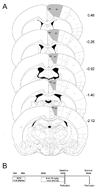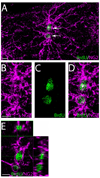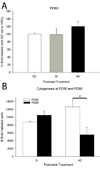Binge-like postnatal alcohol exposure triggers cortical gliogenesis in adolescent rats
- PMID: 19296475
- PMCID: PMC3006179
- DOI: 10.1002/cne.22018
Binge-like postnatal alcohol exposure triggers cortical gliogenesis in adolescent rats
Abstract
The long-term effects of binge-like postnatal alcohol exposure on cell proliferation and differentiation in the adolescent rat neocortex were examined. Unlike the hippocampal dentate gyrus, where proliferation of progenitors results primarily in addition of granule cells in adulthood, the vast majority of newly generated cells in the intact mature rodent neocortex appear to be glial cells. The current study examined cytogenesis in the motor cortex of adolescent and adult rats that were exposed to 5.25 g/kg/day of alcohol on postnatal days (PD) 4-9 in a binge manner. Cytogenesis was examined at PD50 (through bromodeoxyuridine [BrdU] labeling) and survival of these newly generated cells was evaluated at PD80. At PD50, significantly more BrdU-positive cells were present in the motor cortex of alcohol-exposed rats than controls. Confocal analysis revealed that the majority (>60%) of these labeled cells also expressed NG2 chondroitin sulfate proteoglycan (NG2 glia). Additionally, survival of these newly generated cortical cells was affected by neonatal alcohol exposure, based on the greater reduction in the number of BrdU-labeled cells from PD50 to PD80 in the alcohol-exposed animals compared to controls. These findings demonstrate that neonatal alcohol exposure triggers an increase in gliogenesis in the adult motor cortex.
Figures






Similar articles
-
The effects of exercise on adolescent hippocampal neurogenesis in a rat model of binge alcohol exposure during the brain growth spurt.Brain Res. 2009 Oct 19;1294:1-11. doi: 10.1016/j.brainres.2009.07.090. Epub 2009 Aug 6. Brain Res. 2009. PMID: 19647724 Free PMC article.
-
Persistent impairment of hippocampal neurogenesis in young adult rats following early postnatal alcohol exposure.Alcohol Clin Exp Res. 2007 Dec;31(12):2073-82. doi: 10.1111/j.1530-0277.2007.00528.x. Epub 2007 Oct 19. Alcohol Clin Exp Res. 2007. PMID: 17949464
-
Cytogenesis in the adult monkey motor cortex: perivascular NG2 cells are the major adult born cell type.J Comp Neurol. 2015 Apr 15;523(6):849-68. doi: 10.1002/cne.23693. Epub 2014 Dec 2. J Comp Neurol. 2015. PMID: 25308320 Free PMC article.
-
Housing in environmental complexity following wheel running augments survival of newly generated hippocampal neurons in a rat model of binge alcohol exposure during the third trimester equivalent.Alcohol Clin Exp Res. 2012 Jul;36(7):1196-204. doi: 10.1111/j.1530-0277.2011.01726.x. Epub 2012 Feb 10. Alcohol Clin Exp Res. 2012. PMID: 22324755 Free PMC article.
-
Chronic social stress inhibits cell proliferation in the adult medial prefrontal cortex: hemispheric asymmetry and reversal by fluoxetine treatment.Neuropsychopharmacology. 2007 Jul;32(7):1490-503. doi: 10.1038/sj.npp.1301275. Epub 2006 Dec 13. Neuropsychopharmacology. 2007. PMID: 17164819
Cited by
-
Effects of early postnatal alcohol exposure on the developing retinogeniculate projections in C57BL/6 mice.Alcohol. 2013 May;47(3):173-9. doi: 10.1016/j.alcohol.2012.12.013. Epub 2013 Feb 8. Alcohol. 2013. PMID: 23402901 Free PMC article.
-
Chronic ethanol exposure during adolescence in rats induces motor impairments and cerebral cortex damage associated with oxidative stress.PLoS One. 2014 Jun 26;9(6):e101074. doi: 10.1371/journal.pone.0101074. eCollection 2014. PLoS One. 2014. PMID: 24967633 Free PMC article.
-
The effects of exercise on adolescent hippocampal neurogenesis in a rat model of binge alcohol exposure during the brain growth spurt.Brain Res. 2009 Oct 19;1294:1-11. doi: 10.1016/j.brainres.2009.07.090. Epub 2009 Aug 6. Brain Res. 2009. PMID: 19647724 Free PMC article.
-
Neurotoxic effects of alcohol in adolescence.Annu Rev Clin Psychol. 2013;9:703-21. doi: 10.1146/annurev-clinpsy-050212-185610. Epub 2012 Dec 10. Annu Rev Clin Psychol. 2013. PMID: 23245341 Free PMC article. Review.
-
Changes in Representation of Thalamic Projection Neurons within Prefrontal-Thalamic-Hippocampal Circuitry in a Rat Model of Third Trimester Binge Drinking.Brain Sci. 2021 Mar 4;11(3):323. doi: 10.3390/brainsci11030323. Brain Sci. 2021. PMID: 33806485 Free PMC article.
References
-
- Altman J, Das GD. Autoradiographic and histological evidence of postnatal hippocampal neurogenesis in rats. J Comp Neurol. 1965;124(3):319–335. - PubMed
-
- Archibald SL, Fennema-Notestine C, Gamst A, Riley EP, Mattson SN, Jernigan TL. Brain dysmorphology in individuals with severe prenatal alcohol exposure. Dev Med Child Neurol. 2001;43(3):148–154. - PubMed
-
- Arvidsson A, Collin T, Kirik D, Kokaia Z, Lindvall O. Neuronal replacement from endogenous precursors in the adult brain after stroke. Nat Med. 2002;8(9):963–970. - PubMed
Publication types
MeSH terms
Substances
Grants and funding
LinkOut - more resources
Full Text Sources

